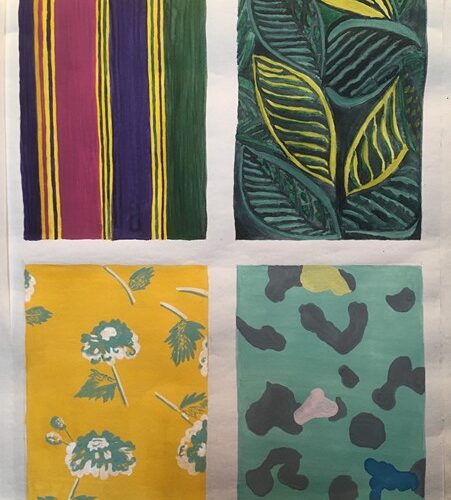
How a foundation course in Drawing for Textile Art, Design and Fashion has interwoven and connected all aspects of my life
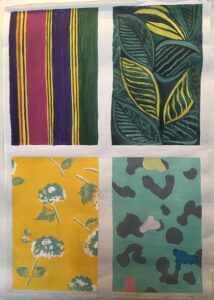
Have you ever found yourself looking at an autumn leaf wondering what colours you would choose to draw it; how would you create the texture and light? Have you ever held a piece of ice, thanks to this winter we had plenty of it, and noticed how in a transparent crystal there are dozens of colours? Have you ever wanted to depict it in your drawing? Before the course, whenever I went to museums or saw paintings in magazines or videos, I tended to read annotations, look for words, a safe place to be because teaching language is what you do all the time… Not anymore.
I can proudly say I have completed these two years of amazing experience of drawing, having dirty and gluey hands from collaging, mixing gouache, breaking and smudging charcoal sticks, watching, and learning to see. Like everybody else, I had doubts: having a one-year-old baby lying near to me whilst I was reading the course outline… only encouraged me to go for it. At one point during the lockdown, remote school learning and working online I thought whether I would be able to finish it at all. My motto was to do whatever and whenever I could. In fact, I visualised the image of a completed folder, assignment 5 feedback, full sketchbooks and this was what kept me going in 2020.
The old saying informs us ‘the devil is not so black as he is painted’. Well, to tell you the truth, in my first drawing I could only see the devil as bad as it could be painted. Carrying on and discovering new books, websites, and challenges presented by my tutor, Rebecca Fairley, led me to the limit which I would never have reached. It benefited not only me: I build my drawing exercises around my work and family, allowing my kids to experiment with my tools and media, wherever possible. I invited them to watch fascinating videos of modern painters, talked to my family about the books and quotes I read and workshops I attended. At home, I reorganised a small bedroom into a study room where I surrounded myself with books, painting tools and drawings.
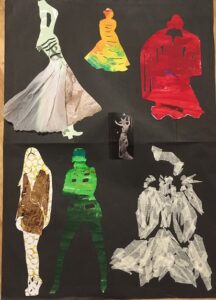
Betty Edwards says, ‘we could teach our children perceptual skills through drawing… – not with the intention of training future artists, but with the intention of teaching students how to transfer perceptual skills
learned through drawing to general thinking skills and problem-solving skills.’ Encouraged by this and by seeing the benefits of drawing on my daily activities, I supported my child starting online drawing lessons. Although he has used nearly a full box of gouache which could have lasted me for a year, he is enjoying it and improving. My family knows that ‘mum is working’ if I close the door in my home office, and my kids have learned to play continuously, and loudly at times, with each other.
What is more, I learn from my children’s innocent, playful approach when they just don’t think of anything and
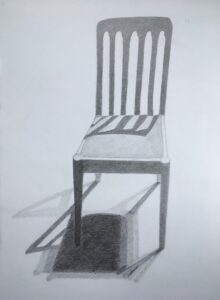
start experimenting with my tools, including flour and charcoal, being themselves, being there, present and not worrying about the outcome. This approach is one to envy and cherish. Picasso’s words were, ‘It took me forty years to learn to draw like a child’. It took me two years to realise that I am not going to create a perfect masterpiece just because I put a pencil to paper. I learned to allow myself to have messy sketches.
On the other hand, it was a discovery for me that I am doing this course secretly. I am a teacher at adult education and completed my teaching degree in 2006. I found it hard to explain to my colleagues, and relatives, why I decided to learn drawing for textile art, and dare dream about becoming a textile designer, in my (very) late 30s. Having worked for the biggest part of my life with words, sentences and languages, and recently solely with my computer screen, I do not regret at all having decided to use my right side of the brain and immerse myself into the study that is practical. Austin Kleon, the author of ‘Steal Like an Artist’ tells us to find a way to bring our body our work. I loved the hands-on processes of mark making, shading, cutting, piercing, pleating, bundle making and even drawing with my hands tied!
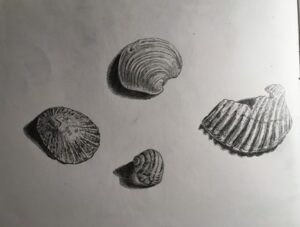
I came to realise that at the beginning I was so eager to reach the perfect result I would be satisfied with, which inevitably equalled to spending a lot of time. However, while doing some exercises outlined by Rebecca, I was relieved to learn that drawing for textile does not require you to draw perfectly, but to be able to research, to try out, to keep experimenting with your ideas only just to do the whole process all over again. I adopt this method in my teaching job too. My confidence grew with each feedback Rebeca gave me and I also started to tell people that I am doing a textile course. The fact that you are expected to possess great drawing skills while doing any art degree will only keep me motivated to continue, to strive, to go out and look out for interesting shapes, colours and forms.
Has this foundation degree improved my teaching? Yes, I am more aware of my daily schedule, I have learned to record my priorities in my diary and I am offered more hours at work. I am more willing to include playful activities into lessons, even though I teach adults. I am feeling my learners’ needs more, seeing their emotions and responding to them by changing activities according to the overall mood of the lesson.
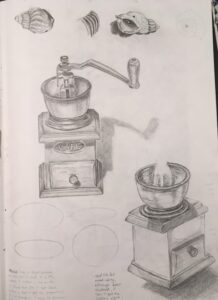
Another discovery for me was that when I look at the drawing, I see the details and try to seize the moment of admiration of the author’s thoughts. I feel my breathing slows down and I notice myself smiling and feeling relaxed, as if I am trying to decipher the message that the artist, the painter, the designer was trying to convey. I need a moment to feel it, to look at it closely and to feel the energy, the grief or love the artist experienced.
I hope it is an advantage and probably a ‘newly discovered’ gift to look at everything more carefully: texture, colours, media used, the way the artist depicts light, hatching, shading. I always watch and wait till that moment – that’s it, I like you, I understand what you are about. Isn’t this the same with music or photos? There are millions of them around us, but I feel that I love to look at some, and not the others. How to reach that level with my paintings and designs? This is a question I am willing to answer when I enrol on my next course. What this ability to watch, to see will lead me to? I don’t know but I would like to find out and I would love to believe it will take me onto a continuous journey of discovery, learning and being alive.
|
|




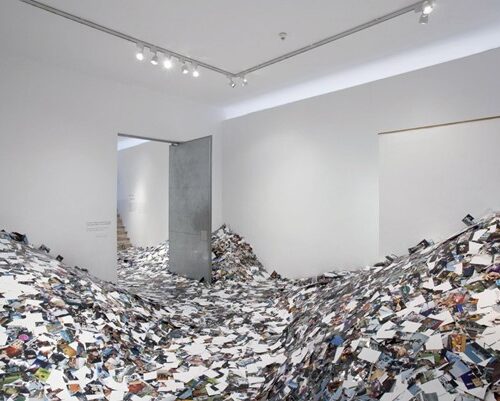


Thank you so much for sharing your thoughts and experiences Yulia. It was a pleasure working with you.
Good luck with whatever you do next.
Thank you for your support Rebecca!
A wonderful read!
Thank you for your feeling!
Great article and tells your unique story whilst resonating with so many students I think.
Thank you for reading. It means a lot to me!
Thank you for sharing! I’ve just signed for this course in a ‘let’s do this’ moment of madness / inspiration! 🙂 I hope I do complete it!
Thank you! Good luck with your course! It was a journey of pleasant discoveries of myself. I already miss it.